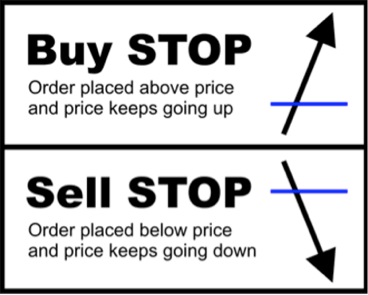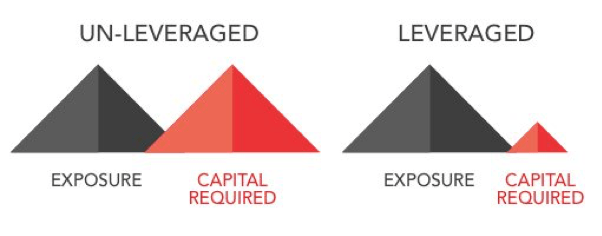Due to a popular demand from less experienced traders, I have written an article describing some trading basics. As with any topic we want to learn and eventually master, the most important part is to begin with the basics. You shouldn’t start trading forex before you gain a clear understanding of the very basic concepts in the forex market. That’s why I will cover 4 different order types, examples of margin and leverage and calculating lot sizes in this article – to make your start in the trading world much easier.
Order Types
The first thing you should know is what types of orders you can place on the forex market. The order types also differ among different forex brokers, but all of them offer the most important order types. These are:
-
Market Orders
-
Limit & Stop Orders
-
Take Profit Orders
-
Stop Loss Orders
A) Market Orders
The most common order type is the market order. With this type of order, you are buying or selling a currency at the best available price the market offers. Let’s say the USD/JPY has a bid price of 110.25 and an ask price of 110.28. If you would like to buy this pair with a market order, you would pay the ask price of 110.28, and if you want to sell the pair, you will be quoted the bid price of 110.25. This difference in the bid and ask price is called the spread, which represents the broker’s profit.
B) Limit & Stop Orders
Limit & stop orders are types of orders which become active only if certain conditions are fulfilled. Both a limit order and stop order can be buy and sell types of orders, which are explained next.
A limit order is placed to buy below the market or sell above the market. Essentially, if you think the price will bounce off of a certain price, but don’t want to wait for the market to reach the price, you would use a limit order.
For example, EUR/USD is trading at $1.1450 and you believe that it will move higher to $1.1480 and then lose ground and fall in price. You would put a sell limit order at $1.1480, and after the price hits this target the order will automatically become a sell market order. You don’t have to wait in front of the screen until the price reaches $1.1480 to enter a sell position!
Stop orders are similar to limit orders, with the only difference that they are used to buy above, or sell below a certain price. The next graphic makes this clearer.
Like in the previous example, if you believe that EUR/USD will move even higher after it reaches $1.1480, you would place a buy stop order at this price and take a walk – the trading platform will make the rest for you and buy the pair at $1.1480.
C&D) Take Profit & Stop Loss Orders
Take profit and stop loss orders automatically close your position once a specific price is reached. They are usually used in combination with other types of orders, as they limit your risk and potential loss. For example, if you enter a buy market order on EUR/USD at 1.1450, you can lock your profits at 1.1500 with a take profit order, which automatically closes the position for you at the prespecified price. It is also mandatory always to use a stop loss order, which limit your losses. In the same example, you could put a stop loss at 30 pips under the market order price is filled – that is at 1.1420. If the price goes against you, you would lose a maximum of 30 pips as the stop loss order automatically closes the position and limit your losses.
Margin
Almost all brokers offer trading on margin and leverage today, so let’s explain these important concepts. A margin is a part of your trading account that is set aside for opening a position on leverage. It’s not as complicated as it seems – think of it as a collateral for opening a position. This is no transaction cost, as many novice traders believe, but a part of your equity which is “locked” as long as the position is open.
It’s similar to a house loan. If you want to buy a $200,000 house on credit, the bank may ask you for a 20% cash participation, which equals $40,000. These $40,000 are still your money, but you used it to buy a house worth $200,000. A margin in the forex market works the same. Think of it as a loan from your broker to open a larger position, and you have to “participate” with a part of your trading account, which is called the margin.
Leverage RatioMargin Requirement as %
1:1 100%
2:1 50%
10:1 10%
50:1 2%
100:1 1%
200:1 0.5%
400:1 0.25%
The table above shows the margin requirements per different leverage ratios. The margin is usually a percentage of the total position size you want to open with leverage. If you use a 1:20 leverage, the required margin would be 5% (100/20). For a 1:50 leverage, the margin would be 2% (100/50), and for a 1:100 leverage, the margin would equal 1% (100/100) of the position size. To better understand the margin, let’s introduce the concept of leverage at this place.
Leverage
Leverage is a very close concept to margin, as these two concepts are interconnected. Leverage offers traders to trade a much larger position than their size of the trading account would allow. This increases potential returns, but also increases the potential risk of a position, as losses are also magnified.
Let’s say you have opened a trading account and deposited $5,000 with the broker. Using leverage, you can open a much larger position than your initial trading capital. With a 1:50 leverage, you are able to open a position 50x as large as your trading capital! For example, if you want to open a position which is worth $100,000 of EUR/USD, with a 1:50 leverage you would only need to allocate $2,000 of your trading account as the required margin to open the position.
Leverage RatioMargin Used as $Purchase Power
1:1 $1,000 $1,000
2:1 $1,000 $2,000
10:1 $1,000 $10,000
50:1 $1,000 $50,000
100:1 $1,000 $100,000
200:1 $1,000 $200,000
400:1 $1,000 $400,000
The table above shows the maximum position sizes that you can open, with a $1,000-margin and different leverage ratios. Just bare in mind that trading on high leverage carries higher risk. In order to try on a risk-free account.
Lot Size
The lot size represents the size of your position. The standard lot size in forex is equal to 100,000 units of a currency, but with the explained concepts of margin and leverage you would only need a margin of $2,000 to open this position on a 1:50 leverage. Other lot sizes are also offered by brokers, like mini lots (10,000 units), micro lots (1,000 units) and nano lots (100 units). The following table shows the different pip values if the base currency is other than USD.
Different currency pairs also impact the value of pips in your position. Let’s see how to calculate the pip value for different currency pairs, using a standard lot size of 100,000 units.
-
EUR/USD at 1.1250: (.0001 / 1.1250) x 100,000 = 8.88 x 1.1250 (to get the $ value) = $9.99, or rounded $10 per pip.
-
USD/JPY at 110.45: (.01 / 110.45) x 100,000 ) = $9.05 per pip.
-
IMPORTANT: Note that we use a slightly different formula than when USD is quoted second, as the result is already expressed in USD. Also, because a pip is the second decimal place in USD/JPY, the formula uses .01 instead .0001 in the beginning. To get a better grasp, try out your trading skills on a trading simulator first.
CONCLUSION: FOREX Basics: Order Types, Margin, Leverage, Lot Size
This article gave you an overview of the basic forex concepts every beginner should know. Order types, margin, leverage and lot sizes – you need to know and understand exactly what they are before opening your first trade at your trading platform! It’s not that difficult, with a little practice and experience you will easily grasp all the mentioned concepts, so you can use them in your daily trading.
This material is written for educational purposes only. By no means do any of its contents recommend, advocate or urge the buying, selling or holding of any financial instrument whatsoever. Trading and Investing involves high levels of risk. The author expresses personal opinions and will not assume any responsibility whatsoever for the actions of the reader. The author may or may not have positions in Financial Instruments discussed in this newsletter. Future results can be dramatically different from the opinions expressed herein. Past performance does not guarantee future results.
Editors’ Picks
EUR/USD climbs to 10-day highs above 1.0700

EUR/USD gained traction and rose to its highest level in over a week above 1.0700 in the American session on Tuesday. The renewed US Dollar weakness following the disappointing PMI data helps the pair stretch higher.
GBP/USD extends recovery beyond 1.2400 on broad USD weakness

GBP/USD gathered bullish momentum and extended its daily rebound toward 1.2450 in the second half of the day. The US Dollar came under heavy selling pressure after weaker-than-forecast PMI data and fueled the pair's rally.
Gold rebounds to $2,320 as US yields turn south

Gold reversed its direction and rose to the $2,320 area, erasing a large portion of its daily losses in the process. The benchmark 10-year US Treasury bond yield stays in the red below 4.6% following the weak US PMI data and supports XAU/USD.
Here’s why Ondo price hit new ATH amid bearish market outlook Premium

Ondo price shows no signs of slowing down after setting up an all-time high (ATH) at $1.05 on March 31. This development is likely to be followed by a correction and ATH but not necessarily in that order.
Germany’s economic come back

Germany is the sick man of Europe no more. Thanks to its service sector, it now appears that it will exit recession, and the economic future could be bright. The PMI data for April surprised on the upside for Germany, led by the service sector.
RECOMMENDED LESSONS
Making money in forex is easy if you know how the bankers trade!
Discover how to make money in forex is easy if you know how the bankers trade!
5 Forex News Events You Need To Know
In the fast moving world of currency markets, it is extremely important for new traders to know the list of important forex news...
Top 10 Chart Patterns Every Trader Should Know
Chart patterns are one of the most effective trading tools for a trader. They are pure price-action, and form on the basis of underlying buying and...
7 Ways to Avoid Forex Scams
The forex industry is recently seeing more and more scams. Here are 7 ways to avoid losing your money in such scams: Forex scams are becoming frequent. Michael Greenberg reports on luxurious expenses, including a submarine bought from the money taken from forex traders. Here’s another report of a forex fraud. So, how can we avoid falling in such forex scams?
What Are the 10 Fatal Mistakes Traders Make
Trading is exciting. Trading is hard. Trading is extremely hard. Some say that it takes more than 10,000 hours to master. Others believe that trading is the way to quick riches. They might be both wrong. What is important to know that no matter how experienced you are, mistakes will be part of the trading process.




